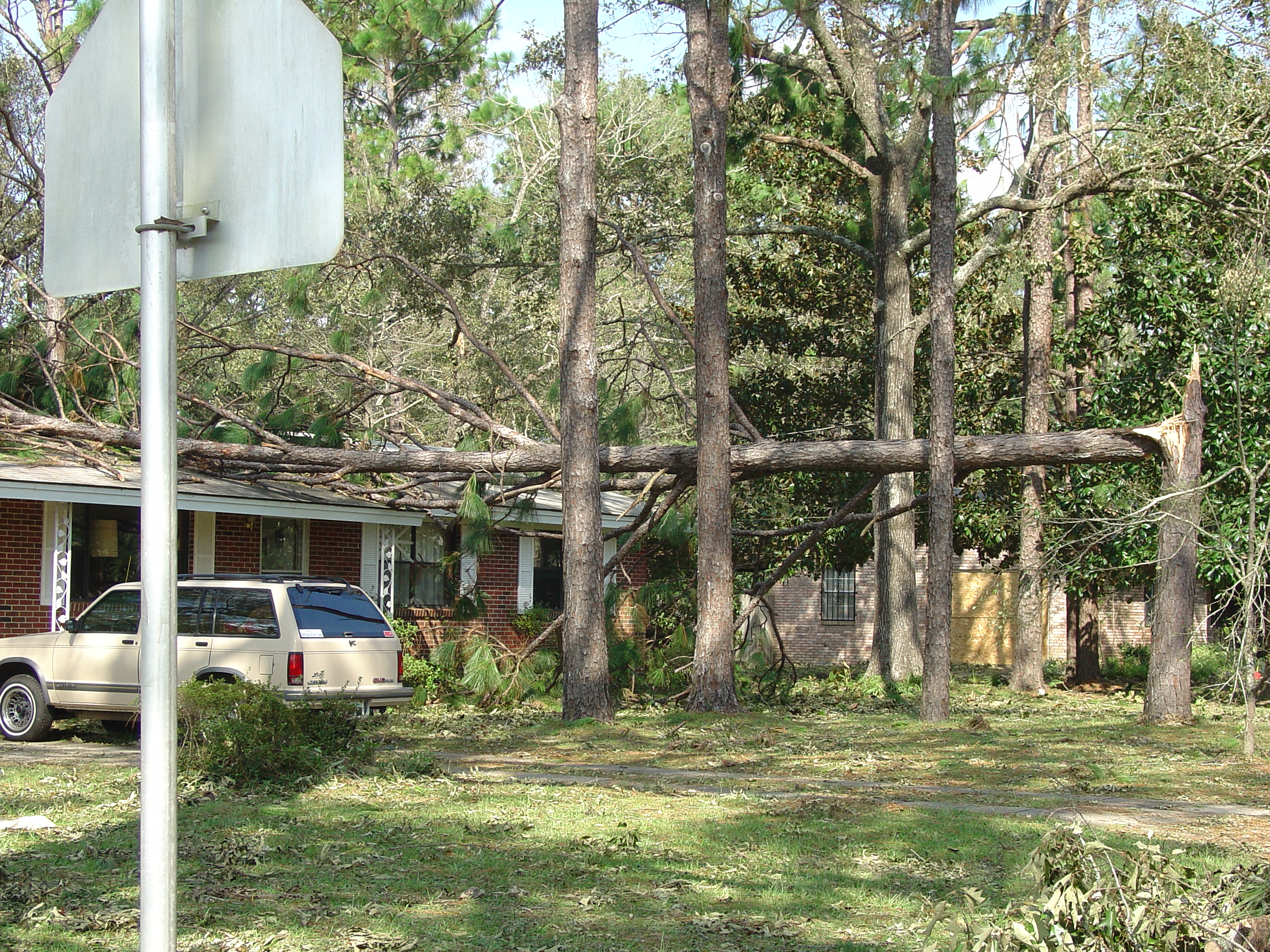
by Larry Williams | Sep 3, 2015
Tropical storm season officially ends November 30. I’m not predicting a storm but even with our average winds during a typical thunderstorm, you’d be wise to prepare.
Falling trees and flying landscape debris during a storm can cause damage. Evaluate your landscape for potential tree hazards. Pruning or removing trees once a hurricane watch has been announced is risky and tree trimming debris left along the street is hazardous.
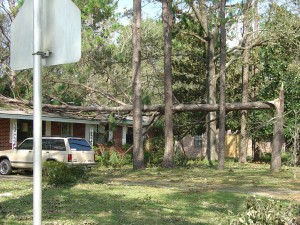
Photo credit: Larry Williams, UF/IFAS.
Now is a good time to remove dead or dying trees and to prune decayed or dead branches Also inspect trees for signs of disease or insect infestation that may further weaken them.
Professional help sometimes is your best option when dealing with larger jobs. Property damage could be reduced by having a professional arborist evaluate unhealthy, injured or questionable trees to assess risk and treat problems. Hiring a certified arborist can be a worthwhile investment. To find a certified arborist in your area contact the International Society of Arboriculture (ISA) at 217-355-9411 or at www.isa-arbor.com. You also may contact the Florida Chapter of ISA at 941-342-0153 or at www.floridaisa.org.
Consider removing trees that have low wind resistance, are at the end of their life span or that have potential to endanger lives or property. For example, laurel oaks are relatively short-lived, usually showing considerable dieback as they reach 50 years. They tend to lose their strength and stability faster than most other oaks and have low wind resistance. Consider removing a big, old laurel oak within falling distance of your home before the next storm.
Tree species with the lowest wind resistance include pecan, tulip poplar, cherry laurel, Bradford pear, southern red oak, laurel oak, water oak, Chinese tallow, Chinese elm, southern red cedar, Leyland cypress, sand pine and spruce pine.
Pine species vary in their wind resistance, usually with longleaf and slash pines showing better survival rates than loblolly and sand pine. However, when pines become large, they may cause damage if located close to homes or other valuable structures.
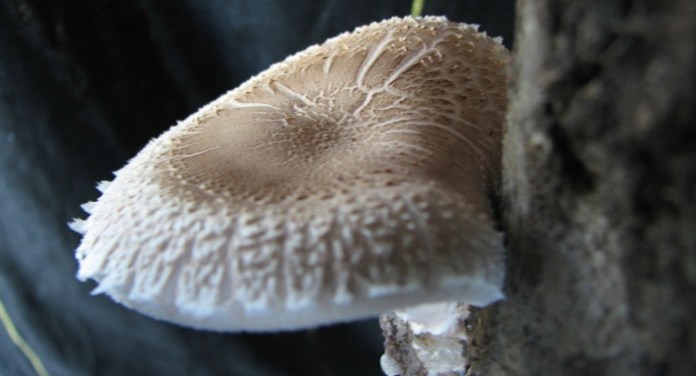
by Matt Lollar | Aug 26, 2015
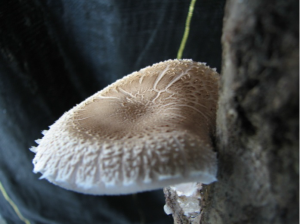
A shiitake mushroom growing on a log. Credit: Clay Olson, UF/IFAS Extension – Taylor County
Mushrooms are an excellent low calorie food with a high fullness factor (they fill you up). But the “common” or “button” mushroom lacks natural flavor. On the other hand, shiitake mushrooms have all the benefits of button mushrooms, but offer a flavor punch and a higher fiber content. However, they are a bit more expensive. Wouldn’t it be great if you could grow mushrooms in the home garden? Growing mushrooms may be easier than you think.
Mushrooms are fungi that grow on rotting organic matter. Shiitake mushrooms are best grown on hardwood logs. Oak logs are generally used for a mushroom food source, but sweetgum, red maple, and poplar can also be used. Logs ranging from a diameter of 2” to 7” and 3’ to 4’ long are recommended. Once the logs have been cut to size, the fungus inoculation process can begin. Holes are drilled into the log and the spawn are inserted. Spawn is a fancy name for the mixture of mushroom roots (mycelium) and a growing substrate (usually made up of compacted sawdust or a wooden dowel). The plugged holes are sealed with wax. The inoculated logs should be placed in a cool, moist, well ventilated place. It can take anywhere from 6 to 18 months for the mycelium to inhabit the logs. This process is called “spawn run” or “incubation”. Mushrooms grow best within a temperature range of 50-70°F, so the fruiting process is a spring or fall event.
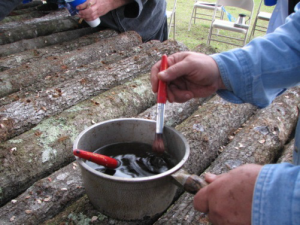
Capping the spawn plugs. Credit: Clay Olson, UF/IFAS Extension – Taylor County
The recommended mushroom strains for Florida are: CS-41; CS-15; CS-24; CS-125; CS-16; CS-11; and CS-118. Favorable conditions are strain-specific, so please do some research before purchasing strains. A list of supply dealers can be found at the North American Mycological Society webpage.
Mushroom production is a fun activity, but it is extremely labor intensive. This article is just a brief summary of process. For more information on producing your own mushrooms, please visit the UF/IFAS Small Farms Mushroom Production webpage. Mushroom production is not a recommended business venture for Florida, but can be a fun hobby.

by Carrie Stevenson | Aug 26, 2015
About two years ago, my son was mowing the lawn when he came across something orange and furry lying in the grass. He backed away and yelled for his dad, but the damage had already been done—he had come across the remains of our orange tabby cat, killed overnight by a larger predator. Emotional repercussions aside, it was startling for our family to realize that even in a residential neighborhood within the city limits, animals were hunting nearby. Based on the experience of seeing one in our own yard just a few months earlier and from other neighbors’ stories, we realized we’d had a coyote attack. Our neighborhood is located relatively close to a large wooded area and a local bayou, and there are plenty of places for coyotes to find shelter.

Always feed your pets indoors and keep them inside at night to prevent coyote attacks. Photo credit: Carrie Stevenson
We learned several lessons after our incident that could be helpful to others living in areas populated with coyotes. Like sharks, coyotes are crepuscular creatures—most actively feeding at dusk and dawn. While they prefer to eat small animals like lizards, rodents, and young birds or deer, they are omnivorous and will also eat fruit and grasses. Not unlike other urban wildlife such as raccoons, they are opportunistic feeders and will scavenge dead animals and garbage. One of the best ways to protect small pets is to keep them (and their food) indoors at night and early morning. Pet food left outdoors often attracts coyotes’ normal prey and therefore the coyotes themselves. It is extremely rare to hear of a coyote attacking a human, but if threatened it is recommended that you yell, throw something, or spray a water hose. Stand your ground and fight back—don’t run, as this will encourage them to give chase.
Coyotes are social animals and often hunt in packs, and like the dogs they’re related to, have excellent vision, hearing, and sense of smell. They will howl and bark to communicate with one another, and hearing these vocalizations is often the first sign that there are some living nearby.
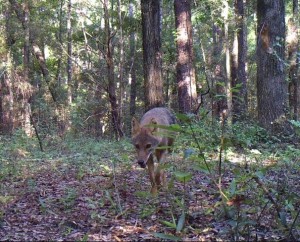
Coyotes are common throughout Florida. Photo credit: W. M. Giuliano
Floridians are no strangers to living with wild animals—we all routinely hear stories of alligators, black bears, venomous snakes, and sharks interrupting our attempts at taming the former wildlands that we now occupy. As urban development marches through the landscape, the large tracts of land once used primarily by animals for hunting and shelter are occupied by human dwellings and transportation routes.
While coyotes are relatively new to Florida (they are native to the western US but entered northwest Florida in the 1970’s), they’ve filled in the ecological gap left by a reduction of native wolves, bobcats, and panthers. Research has shown they now reside in every Florida county and can range the entirety of North America and most of Central America.
Most homeowners will never encounter a coyote, but it is helpful to know they are out there and to take precautions with pets and yard practices to prevent attracting one into your backyard.
For more information on managing coyotes, please visit the UF publication Managing Conflicts with Wildlife: Living with Coyotes.

by Beth Bolles | Aug 26, 2015
It would seem that landscapes are filled with pests ready to devour our favorite plants. We can often see evidence of pest damage in the form of leaf curls, stippled leaves, or chewed holes in foliage. How do plants survive with all the pest threats without intervention from people?
Many plants have their own alert system to help manage a plant-feeding insect attack. When tissues are damaged by plant feeders, the plant releases volatile chemicals that serve as signals for many beneficial insects. Predators such as lady beetles, lacewings, and predatory bugs ‘pick up’ the chemical signals and fly to the injured plants to find their prey.

Ladybeetle larvae will eat many soft-bodied pests.
An interesting part of this occurrence is that the release of chemicals by one plant can stimulate other surrounding plants to build up their chemical defenses against future pest feeding.
The key lesson for all gardeners is that there are many natural processes going on without our knowledge. Instead of immediately applying a broad-spectrum insecticide at the earliest sign of pest feeding on a plant, give the predators a chance to provide you with a free and environmentally sound form of pest control.

by Mary Salinas | Aug 19, 2015
When you know that your lawn needs an application of fertilizer, herbicide, insecticide or fungicide, the question becomes how much to buy and put down. For these products, success stems from applying the right amount, not too much or too little. The label on those products always tells the consumer how many square feet of lawn can be treated, but how do you figure that out?
You could always do it the old-fashioned way with measuring tape and a calculator, estimating the angles and the areas of those curvy, irregular flower beds. This method takes a bit of time and you will still wonder about the accuracy of your final numbers.
Here’s an easier, and more accurate way to do it!
Sod Solutions, Inc. offers an online tool that is easy to use and very accurate. Enter your address and GPS locates the aerial view of your property. Create an overlay by plotting points and the square footage is automatically calculated. The instructions under ‘How to Use the Calculator’ are very clear and makes this tool so easy and convenient to use.
For more information on lawn care topics:
Gardening Solutions: Lawns












